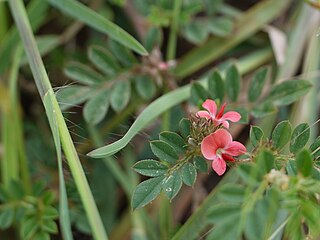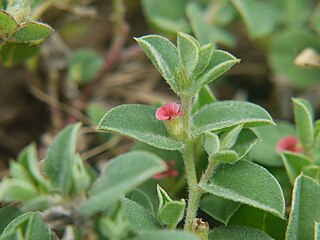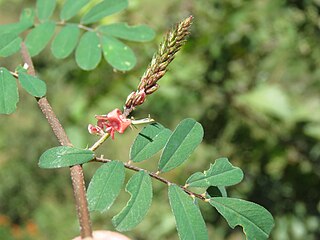
Indigo is a deep color close to the color wheel blue, as well as to some variants of ultramarine, based on the ancient dye of the same name. The word "indigo" comes from the Latin for Indian as the dye was originally exported to Europe from India.

Indigo dye is an organic compound with a distinctive blue color. Historically, indigo was a natural dye extracted from the leaves of some plants of the Indigofera genus, in particular Indigofera tinctoria; dye-bearing Indigofera plants were commonly grown and used throughout the world, in Asia in particular, as an important crop, with the production of indigo dyestuff economically important due to the previous rarity of some blue dyestuffs historically.

Denim is a sturdy cotton warp-faced textile in which the weft passes under two or more warp threads. This twill weaving produces a diagonal ribbing that distinguishes it from cotton duck. While a denim predecessor known as dungaree has been produced in India for hundreds of years, denim as it is recognized today was first produced in Nîmes, France.

Isatis tinctoria, also called woad, dyer's woad, or glastum, is a flowering plant in the family Brassicaceae. It is occasionally known as Asp of Jerusalem. Woad is also the name of a blue dye produced from the leaves of the plant. Woad is native to the steppe and desert zones of the Caucasus, Central Asia to Eastern Siberia and Western Asia but is now also found in South-Eastern and Central Europe and western North America.
Indigo is a color between blue and violet.

Indigofera is a large genus of over 750 species of flowering plants belonging to the pea family Fabaceae. They are widely distributed throughout the tropical and subtropical regions of the world.

Indigofera tinctoria, also called true indigo, is a species of plant from the bean family that was one of the original sources of indigo dye. It has been naturalized to tropical and temperate Asia, as well as parts of Africa, but its native habitat is unknown since it has been in cultivation worldwide for many centuries. Today most dye is synthetic, but natural dye from I. tinctoria is still available, marketed as natural coloring where it is known as tarum in Indonesia and nila in Malaysia. In Iran and areas of the former Soviet Union it is known as basma. The plant is also widely grown as a soil-improving groundcover.

Indigofera suffruticosa, commonly known as Guatemalan indigo, small-leaved indigo, West Indian indigo, wild indigo, and anil, is a flowering plant in the pea family, Fabaceae.

Persicaria tinctoria is a species of flowering plant in the buckwheat family. Common names include Chinese indigo and Japanese indigo. It is native to Eastern Europe and Asia.

Indigofera australis, the Australian indigo or Austral indigo, is an attractive species of leguminous shrub in the genus Indigofera. The genus name Indigofera is Neo-Latin for "bearing Indigo". Australis, from the Latin, means not “Australian” but "southern", referring to the geographical distribution of the species.

Natural dyes are dyes or colorants derived from plants, invertebrates, or minerals. The majority of natural dyes are vegetable dyes from plant sources—roots, berries, bark, leaves, and wood—and other biological sources such as fungi.

Dyeing is the craft of imparting colors to textiles in loose fiber, yarn, cloth or garment form by treatment with a dye. Archaeologists have found evidence of textile dyeing with natural dyes dating back to the Neolithic period. In China, dyeing with plants, barks and insects has been traced back more than 5,000 years. Natural insect dyes such as Tyrian purple and kermes and plant-based dyes such as woad, indigo and madder were important elements of the economies of Asia and Europe until the discovery of man-made synthetic dyes in the mid-19th century. Synthetic dyes quickly superseded natural dyes for the large-scale commercial textile production enabled by the industrial revolution, but natural dyes remained in use by traditional cultures around the world.

Indigofera heterantha, commonly known as Himalayan indigo, is a species of flowering plant in the legume family Fabaceae. It is native to the northwestern Himalayas of Tibet, in Asia.

Indigofera linnaei, known as Birdsville indigo and nine-leaved indigo, is a species of leguminous shrub in the genus Indigofera. The genus name, Indigofera, is derived from Latin and means bearing/containing indigo, while linnaei derives from Linnaeus.

Indigofera decora, commonly known as summer wisteria, is a species of shrub native to China and Japan that has since been introduced to Australia and Sri Lanka. A member of the genus Indigofera, its family is Fabaceae and is used primarily for decorative purposes, though it has also been used to make indigo-colored dye.

Indigofera hirsuta, the hairy indigo or rough hairy indigo, is a species of flowering plant in the family Fabaceae. It is native to nearly all the world's tropics; South America, Africa, Madagascar, the Indian Subcontinent, southern China, southeast Asia, Malesia, Papuasia and Australia, and has been introduced to the Caribbean, the southeast United States, Mexico and Central America. It is used as a green manure and, to a minor extent, for forage.

Indigofera cordifolia, the heart-leaf indigo, is a species of flowering plant in the family Fabaceae. It is found from the Cape Verde Islands, across the Sahel to Oman, the Indian Subcontinent, Guangdong in China, and some of the islands of Indonesia, and it has been introduced to the Northern Territory of Australia. A glycophyte adapted to sandy soils, it is considered a weed in some situations, but can also improve crop yields due to its nitrogen-fixing ability.

Indigofera spicata, the creeping indigo or trailing indigo, is a species of flowering plant in the family Fabaceae. It is native to Sub‑Saharan Africa, Madagascar, Mauritius, Réunion, and Yemen, and has been introduced to the southeastern United States, various Caribbean islands, Brazil and other locations in Latin America, various Pacific islands, and New South Wales and Queensland in Australia. It was considered to be a promising forage plant, and then shown to be toxic to nearly all livestock, but it is possible that the experiments were conducted on the similar Indigofera hendecaphylla, leading to some confusion.

Indigofera hendecaphylla, the creeping indigo or trailing indigo, is a species of flowering plant in the family Fabaceae. It is native to the Old World Tropics and Subtropics, and has been introduced to various locales, including Japan and Australia. It was widely introduced as a forage plant when it was thought to be conspecific with Indigofera spicata, and then shown to be toxic to nearly all livestock, with some uncertainty as to which species was tested.

Indigofera linifolia, the narrowleaf indigo, is a species of flowering plant in the family Fabaceae. It is very widely distributed from Sudan eastwards to the Indian Subcontinent, Southeast Asia, Malesia, New Guinea and Australia, and it has been introduced to Réunion and New Caledonia. Livestock can consume it as fodder, and in times of famine humans can grind and bake the seeds into a bread.

















